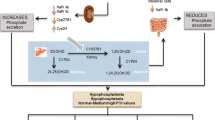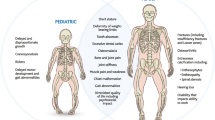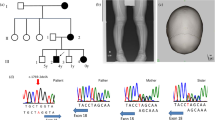Summary
XLH (X-linked hypophosphataemia, gene symbolHYP, McKusick 307800, 307810) and its murine counterparts (Hyp andGy) map to a conserved segment on the X-chromosome (Xp 22.31-p.21.3, human; distal X, mouse). Gene dosage has received relatively little attention in the long history of research on this disease, which began over 50 years ago. Bone and teeth are sites of the principal disease manifestations in XLH (rickets, osteomalacia, interglobular dentin). Newer measures of quantitative XLH phenotypes reveal gene dose effects in bone and teeth with heterozygous values distributed between those in mutant hemizygotes and normal homozygotes. On the other hand, serum phosphate concentrations (which are low in the mutant phenotype and thereby contribute to bone and tooth phenotypes) do not show gene dosage. InHyp mice serum values in mutant hemizygotes, mutant homozygotes and heterozygotes are similar. Phosphate homeostasis reflects its renal conservation. Renal absorption of phosphate on a high-affinity, Na+ ion-gradient coupled system in renal brush border membrane is impaired and gene dosage is absent at this level; the mutant phenotype is fully dominant. Synthesis and degradation of 1,25(OH)2D are also abnormal in XLH (andHyp), but gene dosage in these parameters has not yet been measured. An (unidentified) inhibitory trans-acting product of the X-linked locus, affecting phosphate transport and vitamin D metabolism, acting perhaps through cytosolic protein kinase C, could explain the renal phenotype. But why would it have a normal gene dose effect in bone and teeth? Since the locus may have duplicated (to formHyp andGy), and shows evidence of variable expression in different organs (inner ear, bone/teeth, kidney), it may have been recruited during evolution to multiple functions.
Similar content being viewed by others
References
Agus ZS (1983) Oncogenic hypophosphatemic osteomalacia.Kidney Int 24: 113–123.
Albright F, Butler AM, Bloomberg E (1937) Rickets resistant to vitamin D therapy.Am J Dis Child 54: 529–547.
Alitalo T, Kruse TA, Albertsen HM, Eriksson AW, de la Chapelle A (1991) Genetic mapping of 12 marker loci in the Xp22.3-p21.2 region.Hum Genet 86: 599–603.
Arnaud C, Glorieux F, Scriver C (1971) Serum parathyroid hormone in X-linked hypophosphatemia.Science 173: 845–847.
Aschinberg LC, Solomon LC, Zeis PM, Justice P, Rosenthal IM (1977) Vitamin D resistant rickets associated with epidermal nevus syndrome: Demonstration of a phosphaturic substance in the dermal lesions.J Pediatr 91: 56–60.
Bell CL, Tenenhouse HS, Scriver CR (1988) Primary cultures of renal epithelial cells from X-linked hypophosphatemic (Hyp) mice express defects in phosphate transport and vitamin D metabolism.Am J Hum Genet 43: 293–303.
Boneh A, Tenenhouse HS (1990) Protein kinase C in mouse kidney: Effect ofHyp mutation and phosphate deprivation.Kidney Int 37: 682–688.
Boneh A, Reade TM, Scriver CR, Rishikof E (1987) Audiometric evidence for two forms of X-linked hypophosphataemia in humans, apparent counterparts ofHyp andGy mutations in mouse.Am J Med Genet 27: 997–1003.
Boneh A, Mandla S, Tenenhouse HS (1989) Phorbol myristate acetate activates protein kinase C, stimulates the phosphorylation of endogenous proteins and inhibits phosphate transport in mouse renal tubules.Biochim Biophys Acta 1012: 308–316.
Brault BA, Meyer MH, Meyer RA Jr, Iorio RJ (1987) Mineral uptake by the femora of older female X-linked hypophosphatemic (Hyp) mice but not older maleHyp mice.Clin Orthop Rel Res 222: 289–299.
Buckle VJ, Edwards JH, Evans EP et al (1984) Chromosome maps of man and mouse II.Clin Genet 26: 1–11.
Burnett CH, Dent CE, Harper C, Warland BJ (1964) Vitamin D-resistant rickets.Am J Med 36: 222–232.
Costa T, Marie PJ, Scriver CR et al (1981) X-linked hypophosphatemia: Effect of calcitriol on renal handling of phosphate, serum phosphate and bone mineralization.J Clin Endocrinol Metab 52: 463–472.
Coussens L, Parker PJ, Rhee L et al (1986) Multiple, distinct forms of bovine and human protein kinase C suggest diversity in cellular signalling pathways.Science 233: 859–866.
Cowgill LD, Goldfarb S, Lau K, Slatopolsky E, Agus ZS (1979) Evidence for an intrinsic renal tubular defect in mice with genetic hypophosphatemic rickets.J Clin Invest 63: 1203–1210.
Dent CE (1952) Rickets and osteomalacia from renal tubule defects.J Bone Joint Surg 34B: 266–274.
Dent CE, Harris H (1956) Hereditary forms of rickets and osteomalacia.J Bone Joint Surg 38B: 204–226.
Econs MJ, Pericak-Vance MA, Betz H, Bartlett RJ, Speer MC, Drezner MK (1990) The human glycine receptor: A new probe that is linked to the X-linked hypophosphatemic rickets gene.Genomics 7: 439–441.
Eicher EM, Southard JL, Scriver CR, Glorieux GH (1976) Hypophosphatemia: Mouse model for human familial hypophosphatemic (vitamin D-resistant) rickets.Proc Natl Acad Sci USA 73: 4667–4671.
Ford DM, Molitoris BA (1991) Abnormal proximal tubule apical membrane protein composition in X-linked hypophosphatemic mice.Am J Physiol 260: F317-F322.
Fraser D, Scriver CR (1976) Familial forms of vitamin D-resistant rickets revisited. X-linked hypophosphatemia and autosomal recessive vitamin D dependency.Am J Clin Nutr 29: 1315–1329.
Fraser D, Kooh SW, Scriver CR (1967) Hyperparathyroidism as the cause of hyperaminoaciduria and phosphaturia in human vitamin D deficiency.Pediatr Res 1: 425–435.
Frost HM (1958) Some observations on bone mineral in a case of vitamin D resistant rickets.Henry Ford Hosp Med Bull 6: 300–310.
Giasson SD, Brunette MG, Danan G, Vigneault N, Carrière S (1977) Micropuncture study of renal phosphorus transport in hypophosphatemic vitamin D-resistant rickets mice.Pflugers Arch 371: 33–38.
Glorieux FH, Scriver CR (1972) Loss of a parathyroid hormone-sensitive component of phosphate transport in X-linked hypophosphatemia.Science 175: 997–1000.
Glorieux FH, Scriver CR, Reade TM, Goldman H, Roseborough A (1972). Use of phosphate and vitamin D to prevent dwarfism and rickets in X-linked hypophosphatemia.N Engl J Med 287: 481–487.
Goldstein JL (1986) On the origin and prevention of PAIDS (paralyzed academic investigator's disease syndrome).J Clin Invest 78: 848–854.
Hammerman MR, Chase LR (1983) Pi transport, phosphorylation, and dephosphorylation in renal membranes fromHyp/Y mice.Am J Physiol 245: F701-F706.
Hardy DC, Murphy WA, Siegel BA, Reid IR, Whyte MP (1989) X-linked hypophosphatemia in adults: Prevalence of skeletal radiographic and scintigraphic features.Radiology 171: 403–414.
Harvey N, Tenenhouse HS (1992) Renal Na+-phosphate co-transport in X-linkedHyp mice responds appropriately to Na+-gradient, membrane potential and pH.J Bone Miner Res 7: 563–571.
Hillyard AL, Doolittle DP, Davisson MT, Roderick TM (1991) Newsletter: Locus map of mouse with comparative map points of human or mouse. The Jackson Laboratory, Bar Harbour, ME 04609. Map for August 1991.
Insogna KL, Broadus AE, Gertner JM (1983) Impaired phosphorus conservation and 1,25-dihydroxyvitamin D generation during phosphorus deprivation in familial hypophosphatemic rickets.J Clin Invest 71: 1562–1569.
Kacser M, Burns JA (1981) The molecular basis of dominance.Genetics 97: 639–666.
Kruse K, Kracht U, Gopfert G (1982) Renal threshold phosphate concentration (TmPO4/GFR).Arch Dis Child 57: 217–223.
Lobaugh B, Drezner MK (1983) Abnormal regulation of renal 25-hydroxyvitamin D-1α-hydroxylase activity in the X-linked hypophosphatemic mouse.J Clin Invest 71: 400–403.
Lyon MF (1988) The William Allan Memorial Award Address: X-chromosome inactivation and the location and expression of X-linked genes.Am J Hum Genet 42: 8–16.
Lyon MF, Scriver CR, Baker LRI, Tenenhouse HS, Kronick J, Mandla S (1986) TheGy mutation: Another cause of X-linked hypophosphatemia in mouse.Proc Natl Acad Sci USA 83: 4899–4903.
Machler M, Frey D, Gal A et al (1986) X-linked dominant hypophosphatemia is closely linked to DNA markers DXS41 at Xp22.Hum Genet 73: 271–275.
Mandla S, Boneh A, Tenenhouse HS (1990) Evidence for protein kinase C involvement in the regulation of renal 25-hydroxyvitamin D3-24-hydroxylase.Endocrinology 127: 2639–2647.
Meyer RA Jr, Gray RW, Meyer MH (1980) Abnormal vitamin D metabolism in the X-linked hypophosphatemic mouse.Endocrinology 107: 1577–1581.
Meyer RA Jr, Meyer MH, Gray RW (1989a) Parabiosis suggests a humoral factor is involved in X-linked hypophosphatemia in mice.J Bone Min Res 4: 493–500.
Meyer RA Jr, Tenenhouse HS, Meyer MH, Klugerman AH (1989b) The renal phosphate transport defect in normal mice parabiosed to X-linked hypophosphatemic mice persists after parathyroidectomy.J Bone Min Res 4: 523–532.
Meyer RA Jr, Mandla S, Tenenhouse HS, Gray RW, Meyer MH (1991) Increased renal 25-hydroxyvitamin D3-24-hydroxylase may explain the failure of Gyro (Gy) mice to respond to low phosphate diet with increased plasma 1,25-dihydroxyvitamin D.J. Bone Min Res 6: S294.
Miyauchi A, Fukase M, Tsutsumi M, Fujita T (1988) Hemangiopericytoma-induced osteomalacia. Tumor transplantation in nude mice causes hypophosphatemia and tumor extracts inhibit renal 25-hydroxyvitamin D 1-hydroxylase activity.J Clin Endocrinol Metab 67: 46–53.
Nakagawa N, Arab N, Ghishan FK (1991) Characterization of the defect in the Na+-phosphate transporter in vitamin D-resistant hypophosphatemic mice.J Biol Chem 266: 13616–13620.
Nesbitt T, Drezner MK, Lobaugh B (1986) Abnormal parathyroid hormone stimulation of 25-hydroxyvitamin D-1α-hydroxylase activity in the hypophosphatemic mouse.J Clin Invest 77: 181–187.
Nesbitt T, Davidai GA, Drezner MK (1989) Abnormal adenosine 3′5′-monophosphate stimulation of renal 1,25-dihydroxyvitamin D production inHyp mice: Evidence that 25-hydroxyvitamin D-1α-hydroxylase activity dysfunction results from aberrant intracellular function.Endocrinology 124: 1184–1189.
Nesbitt T, Coffman TM, Drezner MK (1990) Cross-transplantation of kidneys in normal andHyp mice. Evidence that theHyp phenotype is unrelated to an intrinsic renal defect.J Bone Min Res 5: S205.
Piatigorsky J, Wistow G (1991) The recruitment of crystallins: New functions precede gene duplication.Science 252: 1078–1079.
Rasmussen H, Tenenhouse HS (1989) Hypophosphatemia. In Scriver CR, Beaudet A, Sly W, Valle D, eds.The Metabolic Basis of Inherited Disease. New York: McGraw-Hill, 2581–2601.
Read AP, Thakker RV, Davies KE et al (1986) Mapping of human X-linked hypophosphatemic rickets by multilocus linkage analysis.Hum Genet 73: 267–270.
Reid IR, Hardy DC, Murphy WA, Teitelbaum SL, Bergfeld MA, Whyte MP (1989) X-linked hypophosphatemia: Clinical, biochemical and histopathologic assessment of morbidity in adults.Medicine 68: 336–352.
Reid IR, Murphy WA, Hardy DC, Teitelbaum SL, Bergfeld MA, Whyte MP (1991) X-linked hypophosphatemia: Skeletal mass in adults assessed by histomorphometry, computed tomography, and absorptiometry.Am J Med 90: 63–69.
Scriver CR (1971) Fondements biologiques de la sensibilités du rachitisme à la vitamine D.L'Union Med du Canada 100: 462–474.
Scriver CR (1974) Rickets and the pathogenesis of impaired tubular transport and other solutes.Am J Med 57: 43–49.
Scriver CR, Tenenhouse HS (1981) On the heritability of rickets, a common disease (Mendel, mammals and phosphate).Johns Hopkins Med J 149: 179–187.
Scriver CR, Tenenhouse HS (1990) Conserved loci on the X-chromosome confer phosphate homeostasis in mice and humans.Genet Res (Camb 56: 141–152.
Scriver CR, Tenenhouse HS (1991) Mendelian phenotypes as probes of renal transport systems for amino acids and phosphate. In Windhager EF, ed.Handbook of Renal Physiology. Oxford: Oxford University Press (in press).
Scriver CR, Kronick J, Tenenhouse HS (1990) Gene dose effects in human and murine X-linked hypophosphatemia (XLH): Skewed dose effect in kidney. (Abstract).Am J Hum Genet 47: A166.
Scriver CR, Tenenhouse HS, Glorieux FH (1991) X-linked hypophosphatemia: An appreciation of a classic paper and a survey of progress since 1958.Medicine 70: 215–228.
Searle AG, Peter J, Lyon MF et al (1989) Chromosome maps of man and mouse. IV.Ann Hum Genet 53: 89–140.
Shields ED, Scriver CR, Peade T et al (1990) X-linked hypophosphatemia: The mutant gene is expressed in teeth as well as kidney.Am J Hum Genet 46: 434–442.
Smith R, O'Riordan JLH (1987) Of mouse and man: The hypophosphatemic genes.Q J Med 64: 705–707.
Tenenhouse HS (1983) Abnormal renal mitochondrial 25-hydroxyvitamin D3-1-hydroxylase activity in the vitamin D and calcium deficient X-linkedHyp mouse.Endocrinology 113: 816–818.
Tenenhouse HS (1984a) Metabolism of 25-hydroxyvitamin D3 in renal slices from the X-linked hypophosphatemic (Hyp) mouse: Abnormal response to fall in serum calcium.Cell Cal 5: 43–55.
Tenenhouse HS (1984b) Investigation of the mechanism for abnormal renal 25-hydroxyvitamin D3-1-hydroxylase activity in the X-linkedHyp mouse.Endocrinology 115: 634–639.
Tenenhouse HS (1988) Vitamin D metabolism and phosphate transport in developing kidney: effect of diet and mutation.Pediatr Nephrol 2: 171–175.
Tenenhouse HS, Henry HL (1985) Protein kinase activity and protein kinase inhibitor in mouse kidney: Effect of the X-linkedHyp mutation and vitamin D status.Endocrinology 117: 1719–1726.
Tenenhouse HS, Jones G (1990) Abnormal regulation of renal vitamin D catabolism by dietary phosphate in murine X-linked hypophosphatemic rickets.J Clin Invest 85: 1450–1455.
Tenenhouse HS, Lee J (1990) Sulfate inhibits14C-phosphonoformic acid binding to renal brush border membranes.Am J Physiol 259: F286-F292.
Tenenhouse HS, Scriver CR (1978) The defect in transcellular transport of phosphate in the nephron is located in brush-border membranes in X-linked hypophosphatemia (Hyp mouse model).Can J Biochem 56: 640–646.
Tenenhouse HS, Scriver CR (1991) X-linked hypophosphatemia. A phenotype in search of a cause.Int J Biochem (in press).
Tenenhouse HS, Scriver CR (1981) Effect of 1,25-dihydroxyvitamin D3 on phosphate homeostasis in the X-linked hypophosphatemic (Hyp) mouse.Endocrinology 109: 658–660.
Tenenhouse HS, Scriver CR, McInnes RR, Glorieux FH (1978) Renal handling of phosphate in vivo and in vitro by the X-linked hypophosphatemic male mouse: Evidence for a defect in the brush border membrane.Kidney Int 14: 236–244.
Tenenhouse HS, Cole DEC, Scriver CR (1981a) Mendelian hypophosphatemias as probes of phosphate and sulfate transport by mammalian kidney. In Belton NR, Toothill C, eds.Transport and Inherited Disease. New York: MTP Press, 231–262.
Tenenhouse HS, Fast DK, Scriver CR, Koltay M (1981b) Intestinal transport of phosphate anion is not impaired in theHyp (Hypophosphatemic) mouse.Biochem Biophys Res Commun 100: 537–543.
Tenenhouse HS, Yip A, Jones G (1988) Increased renal catabolism of 1,25-dihydroxyvitamin D3 in murine X-linked hypophosphatemic rickets.J Clin Invest 81: 461–465.
Tenenhouse HS, Klugerman AH, Neal JL (1989) Effect of phosphonoformic acid, dietary phosphate and theHyp mutation on kinetically distinct phosphate transport processes in mouse kidney.Biochim Biophys Acta 984: 207–213.
Tenenhouse HS, Lee J, Harvey N, Potier M, Jetté M, Béliveau R (1990) Normal molecular size of the Na+-phosphate transport and normal Na+-dependent binding of phosphonoformic acid in renal brush border membranes of X-linkedHyp mice.Biochem Biophys Res Commun 170: 1288–1293.
Thakker RV, Read A, Davies KE et al (1987) Bridging markers defining the map position of X-linked hypophosphatemic rickets.J Med Genet 24: 756–760.
Thakker RV, Davies KE, Read AP et al (1990) Linkage analysis of two cloned DNA sequences, DXS197 and DXS207, in hypophosphatemic rickets families.Genomics 8: 189–193.
Walker JJ, Yan TS, Quamme GA (1987) Presence of multiple sodium-dependent phosphate transport processes in proximal brush-border membranes.Am J Physiol 252: F226-F231.
Werner A, Biber J, Forgo J, Palacin M, Murer H (1990) Expression of renal transport systems for inorganic phosphate and sulfate inXenopus laevis oocytes.J Biol Chem 265: 12331–12336.
Werner A, Moore ML, Mantei N, Biber J, Semenza G, Murer H (1991) Cloning and expression of cDNA for a Na/Pi cotransport system of kidney cortex.Proc Natal Acad Sci USA 88: 9608–9612.
Winters RW, Graham JB, Williams TF, McFalls VW, Burnett CH (1958) A genetic study of familial hypophosphatemia and vitamin D resistant rickets with a review of the literature.Medicine 37: 97–142.
Yamaoka K, Seino Y, Satomura K, Tanaka Y, Yabuuchi H, Haussler MR (1986) Abnormal relationship between serum phosphate concentration and renal 25-hydroxycholecalciferol-1-α-hydroxylase activity in X-linked hypophosphtemic mice.Min Electrolyte Metab 12: 194–198.
Author information
Authors and Affiliations
Rights and permissions
About this article
Cite this article
Scriver, C.R., Tenenhouse, H.S. X-linked hypophosphataemia: A homologous phenotype in humans and mice with unusual organ-specific gene dosage. J Inherit Metab Dis 15, 610–624 (1992). https://doi.org/10.1007/BF01799618
Issue Date:
DOI: https://doi.org/10.1007/BF01799618




